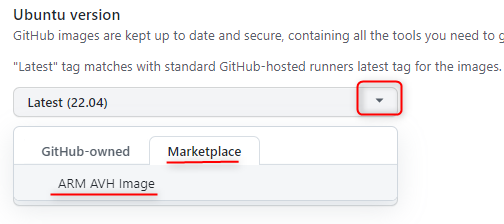Arm Virtual Hardware (AVH) is available as a GitHub-hosted Runner that greatly simplifies use of AVH for projects maintained in GitHub repositories.
AVH Runner image is a Ubuntu Linux virtual machine (VM) hosted by GitHub that contains ready-to-use Arm processor simulation models, compiler toolchains and other utilities. It natively integrates with GitHub Actions enabling simple setup of Continuous Integration (CI) workflows for building and testing embedded software projects based on Arm Cortex-M processors.
AVH GitHub Runner Image Inventory lists the tools provided on the AVH GitHub Runner.
The following sections explain the setup of AVH GitHub Runner and its usage in different scenarios.
Sign up to join the beta access to Arm Virtual Hardware for GitHub Actions.
AVH GitHub Runner is available for GitHub Organization and Enterprise accounts, see Types of GitHub Accounts.
If the use of AVH GitHub Runner is enabled for your organization, you can create an AVH Runner as follows:


With an AVH Runner created in your organization, you can use the runner group to manage the access policy to the Runner from organization repositories, similar as explained in Managing access to self-hosted runners using groups. By default, access needs to be enabled for each repository, but the policy can be changed to enable the runners in specific runner group for all repositories in the organization.
To verrify if your AVH runner is available for a specific repository:

If the target runner is not listed, please verify that it is enabled for the organization and the repository, as described in Adding AVH Runner.
When AVH Runner is available for the target repository, you can start using it for GitHub Action workflow jobs.
In the YAML file that describes the GitHub Actions workflow you can now specify the AVH Runner as the destination machine to run the job on. Use runs-on followed by the AVH Runner name as was provided when Adding AVH Runner. Below is an example of such job definition:
Read more about runs-on for specifying runners in Choose the runner for the job.
As the AVH Runner is a Ubuntu based machine, you can use many common utilities for your job. AVH-specific services are available as described in subsections below.
AVH simulation models are located at /opt/VHT/ and can be run from there using command line commands as explained in Using Arm Fixed Virtual Platforms. This can be done directly in the .yaml file that specifoies the GitHub Action, or abstracted with a custom script. For example a step for running the hello.axf binary on a Cortex-M3 model can be done as a step in the GitHub Action yaml as:
See AVH GitHub Runner Image Inventory for the list of models provided on the AVH GitHub Runner.
Example workflows demonstrate the software execution on FVP models.
AVH Runner includes following toolchains pre-installed and ready to use:
/opt/armcompiler//opt/gcc-arm-11.2-2022.02-x86_64-arm-none-eabi/See AVH GitHub Runner Image Inventory for the list of toolchains provided on the AVH GitHub Runner.
The repository github.com/ARM-labs provides several examples that use AVH runner for GitHub Actions:
The examples are constructed with Open-CMSIS-Pack support and the firmware images are built from command line using the CMSIS-Pack development tools. This simplifies support of several compiler toolchains and multiple targets.